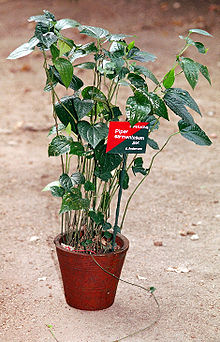- Piper sarmentosum
-
Piper sarmentosum 
A Piper sarmentosum plant Scientific classification Kingdom: Plantae (unranked): Angiosperms (unranked): Magnoliids Order: Piperales Family: Piperaceae Genus: Piper Species: P. sarmentosum Binomial name Piper sarmentosum
Roxb.Piper sarmentosum is a plant in the Piperaceae family used in many Southeast Asian cuisines. The leaves are often confused with betel,[1] but they lack the intense taste of the betel leaves and are significantly smaller.
Contents
Names
There is no "official" English name for it, but it is sometimes called wild betel. It is known as cha plu (ช้าพลู) in Thai, phak i leut or pak eelerd (ຜັກອີ່ເລີດ) in Lao and pokok kadok in Malay. In Vietnam, the local name of Piper lolot – lá lốt – is applied to P. sarmentosum also.
Geographic distribution
P. sarmentosum is found from the tropical areas of Southeast Asia, Northeast India and South China, and as far as the Andaman Islands.[2]
In cuisine
P. sarmentosum leaves are sold in bunches and are usually eaten raw.
- In Thai cuisine, it is used to wrap miang kham, a traditional snack.
- In Laotian cuisine, it is eaten as part of a salad.
- In Malay cuisine it is shredded for ulam, a type of Malay salad.
In medicine
P. sarmentosum leaves are used in traditional Asian medicines. Chemical analysis has shown the leaves contain high amounts of the antioxidant naringenin.[3] Amides from P. sarmentosum fruit have been shown to have anti-tuberculosis and anti-plasmodial activities.[4]
References
- ^ "Piper sarmentosum". Asia Food Glossary. Asia Source. http://www.asiafood.org/glossary_2.cfm?wordid=3252. Retrieved 2008-09-08.
- ^ "Piper sarmentosum Roxb. – An addition to the flora of Andaman Islands". Current Science 87 (2). July 25, 2004. http://www.ias.ac.in/currsci/jul252004/141.pdf. Retrieved 2008-09-08.
- ^ Subramaniam, Vimala. "Natural Antioxidants: Piper sarmentosum (Kadok) and Morinda elliptica (Mengkudu)". Malaysian Journal of Nutrition 9 (1). http://myais.fsktm.um.edu.my/2713/. Retrieved 2008-09-08.
- ^ "Chemical constituents and bioactivity of Piper sarmentosum". Journal of Ethnopharmacology 93 (2–3). August 2004. doi:10.1016/j.jep.2004.01.022. PMID 15234750. http://www.sciencedirect.com/science?_ob=ArticleURL&_udi=B6T8D-4CMW3VJ-1&_user=10&_rdoc=1&_fmt=&_orig=search&_sort=d&view=c&_version=1&_urlVersion=0&_userid=10&md5=16b13555b36dedac944e126335bac61f. Retrieved 2008-09-08.
Categories:- Piper
- Flora of India
- Herbal and fungal stimulants
- Medicinal plants
- Plants described in 1810
- Thai ingredients
Wikimedia Foundation. 2010.
